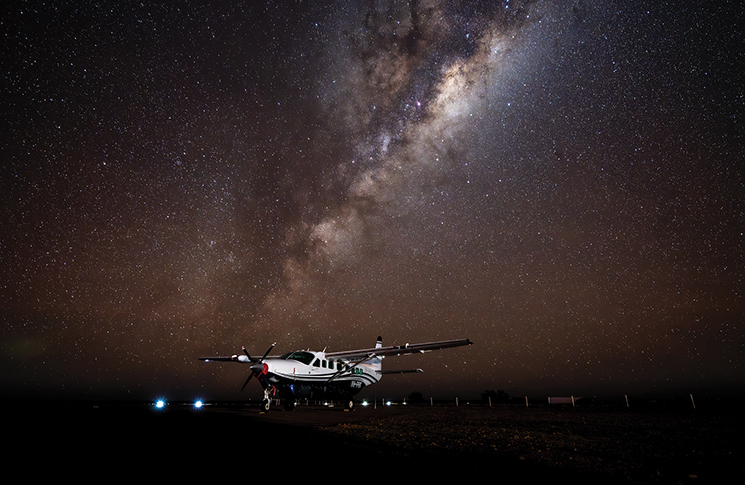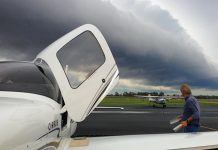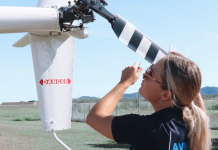In the early 1980s, Cessna embarked on a project to develop a more modern light aircraft capable of delivering the large payloads that traditionally had been handled by older designs like the Douglas DC-3, the DHC-3 Otter and DHC-6 Twin Otter. Later designs like the Beechcraft B200 and Cessna 441 had some ability to fill these roles, but each had limitations and challenges.
Initially developed from the fuselage of a Cessna 207, the new aircraft became the Cessna 208 Caravan. A true go-anywhere, bring anything aeroplane, it proved incredibly popular. FedEx placed orders for a cargo-only variant of the original C208, as well as the larger C208B, eventually taking delivery of more than 200 aircraft over the few decades. As of 2025, more than 3,000 have been delivered and, more than 40 years after certification, the aircraft remains in production.
FedEx’s use for the C208 was as a freight feeder – the aircraft was perfect for delivering cargo to and from smaller regional airports. There’s a saying among freight pilots, ‘freight’s gotta go.’ For FedEx, this meant they needed the Caravan to be capable of flying every single day, even in the middle of an American winter.
Cessna fitted a suite of equipment to protect the Caravan against icing conditions. Inflatable, black neoprene boots on the front of the wings, struts and stabilisers to remove ice accretions. A heated propeller. A bypass system on the engine air intake to separate ice particles, snow and hail before they enter the compressor. Heated pitot and static systems.
When fitted with the optional ice protection package, the aircraft was certified as being capable of flight into known icing (FIKI).
Finding limits
Fundamentally, the Caravan is a very capable aeroplane. Useful loads in excess of 1,500 kg. Simple to maintain. Easy for pilots to operate. Incredibly reliable. But over the first 15 years of operation, the limitation of the aircraft, and its icing certification, became progressively apparent.
In 1990, 29 January was a typical winter’s day for the eastern states of the US. Light snow in the day progressed into snow showers in the evening, with temperatures on the ground sitting below freezing. At around 8 pm local time, 2 C208s, were preparing to depart on freight feeder flights – one from Clinton County, New York, and one from Burlington, Vermont. The airports were 25 nm apart, separated by Lake Champlain.
At 8:31 pm, the first Caravan, departed Clinton County in wet snow. The aircraft climbed to 700 feet, turned and made a steep descent. It struck trees, inverted, killing the pilot. Two other C208s had departed ahead of the accident aircraft, later reporting icing conditions had affected their climb.
At 8:58 pm, over at Burlington the other Cessna 208, began its take-off roll into icing conditions, with 2 pilots on board, in moderate snow. Unfortunately, the accident report is silent on this detail, but it’s unlikely these pilots were aware of the accident that had just unfolded nearby.
The Burlington aircraft struggled to get airborne, lumbering into the air before striking trees a mile off the end of the runway. Neither pilot survived the crash and subsequent fire.
The NTSB investigations into the accidents attributed both to contamination of the wings with ice, leading to compromised performance and loss of control. The aircraft out of Burlington was found to have also been 360 lb (163 kg) above the structural weight limit for the aircraft, as well as 1,100 lb (499 kg) above the performance weight limit for flight in icing conditions.
The January 29 crashes were tragic, but worse, they marked the beginning of a string of fatal icing accidents involving the type. Only a month later, another C208 crashed in icing conditions in Denver, Colorado, fatally injuring the sole occupant on board.

Design and usage
Like many other aircraft sharing its design features, the Cessna 208 are a type that is susceptible to icing.
They’ve got a large frontal area, with the thick, high-lift wing offering plenty of places for ice to accrete. They also operate at lower levels at slower speeds, meaning they generally spend a lot longer in icing conditions than pressurised competitors like Beechcraft King Airs or Cessna Conquests.
Caravans were originally certified with neoprene ice boots on the wings which inflate to break ice from the leading edge of the wing. They are still used but they aren’t perfect. Residual ice can remain on the boots after activation. They also only protect the leading edge of the wing; the surface area behind the boot is offered limited protection for ice formations that run back across the wing.
In practice, ice accretion adds weight and drag which ultimately decreases speed. Ice also changes the performance of the wing, raising the stalling speed, providing pilots an increasingly narrow speed window to operate in as icing conditions worsened.
Regulators take note
Three further icing accidents involving the C208 occurred in 1994 and 1995. Cessna launched a safety awareness program. In 1996 the US Federal Aviation Administration (FAA) issued Airworthiness Directive (AD) 96-09-15 which amended the C208 flight manual to include explicit guidance on how to recognise icing conditions and more guidance on managing them.
The Caravan is not alone in having challenges with icing. AD 96-09-15 was in fact one of many ADs issued in 1996 specifically improving guidance to pilots on recognising icing conditions.
Unfortunately, icing accidents in C208s continued into the early 2000s, both fatal and non-fatal. Perhaps most concerning was that these events were happening to experienced pilots – both in terms of total experience in bad weather and time on type. The accidents weren’t limited to inadequate removal of ice and snow before take-off – 15 of the 26 icing events had been from in-flight icing accumulations.
Icing must be viewed as hazardous on every flight and the limitations for flight in icing conditions must be observed.
Through 2003 and 2004, the US National Transport Safety Board conducted a study into the numerous accidents involving the type, and by December 2004 it had made several recommendations, including that mandatory training for flight in icing conditions be conducted on an annual basis.
Working with the FAA, Cessna conducted flight tests with various ice shapes on the wings to allow it to better understand the effectiveness of the stall warning with ice accretions. In several of the accidents, no warning sounded as the aircraft stalled at speeds well above the published stalling speed. The only protection against a stall and loss of control in icing conditions was maintaining speed well above the published stalling speed.
The findings of these flights lead to AD 2005-07-01, requiring exit from icing conditions if speed decayed below 120 knots, and instructing pilots to sacrifice altitude to keep an absolute minimum airspeed of 105 knots.
A flight test in March 2005 conducted by Cessna and the FAA had to be terminated early after the aircraft encountered natural moderate icing conditions and slowed from 133 knots to 120 knots in only 9 minutes.

Later that year, another Caravan and pilot were lost only 5 minutes after take-off in Winnipeg, Canada into icing conditions that were considered moderate. The following month another 208 was lost in Voronezh, Russia, again the result of moderate icing.
Recommendations from the Canadian Transport Safety Bureau, an industry task force and the FAA led to several ADs in 2006 and eventually AD 2007-10-15. It implemented a suite of restrictions to the aircraft’s FIKI certification, including:
- installation of a low airspeed awareness system to warn pilots if their speed decayed below the prescribed minimum speed for flight in icing.
- a requirement to disconnect the autopilot at first sign of ice accretion to prevent an autopilot from masking control forces required due to icing.
- prohibition of flight into icing conditions more than ‘light’, including clear parameters about speed decay and visible cues to determine this.
This latest AD effectively put an end to the fatal icing accidents on the Caravan, but also effectively stripped its ability to fly anything but the lightest of icing.
Recertification
Responding to customers who still wanted their Caravans to be capable of flight in more serious icing, Cessna recertified the Caravan for flight icing conditions with a more comprehensive ‘TKS’ fluid anti-icing package.
Ice protection systems can be cold comfort when conditions exceed the capability of the aircraft or the pilot flying it.
The package gets its name from the companies that designed the system in the 1940s – Tecalemit, Kilfrost and Sheepbridge Stokes. TKS icing protection systems pump anti-icing fluid, commonly ethylene glycol, through porous panels on the leading edges of wings and surfaces to depress the freezing temperature of water impacting the wing, preventing ice formation. It is generally superior to neoprene boots as it offers protection to the entire wing surface, not just the leading edge.
Through the use of this system, the Caravan was able to regain most of the icing capability that was originally intended. Despite this, the aircraft flight manual (AFM) supplement for flight into known icing is 86 pages and details a litany of limitations, including prohibition of operation in severe icing conditions and mandatory annual training on the icing systems through an online course offered by Cessna.
Cessna is not alone in mandating further learning for pilots operating in icing conditions; Cirrus has a similar course at 24-month intervals mandated for pilots of TKS-equipped SR22 aircraft. The SR22 also has an imperfect history in icing, with fatal accidents in the 2000s prior to FIKI certification of the type in 2009.
Accidents
The reality of flying in icing conditions is that, even in FIKI-certified aircraft, ice protection systems can be cold comfort when conditions exceed the capability of the aircraft or the pilot flying it. Icing must be viewed as hazardous on every flight and the limitations for flight in icing conditions must be observed. Many aircraft manuals mandate having planned escape routes – commonly descent into warmer air – when using ice protection.
Higher performance types are not immune; in October 2024, a Beechcraft B200 King Air, VH-ZMW, encountered severe ice west of Toowoomba, Queensland, and was forced to divert to Roma. The ATSB is investigating the occurrence. King Airs, like many turbine twins approved for FIKI, are not certified for sustained flight in severe icing conditions.
The Mitsubishi MU2 is another prime example of this. Two fatal MU2 icing accidents in Western Australia in 1988 and 1990 are well documented in this magazine and elsewhere; both involved operation in icing conditions beyond the aircraft’s capability. The use of history can help you understand where other pilots have faltered.
Pilots must not assume that the mere existence of icing protection equipment alone is sufficient to protect them. Weather conditions can quickly lead to increased icing beyond the capability of the aircraft. Always plan an escape, remember the limitations of your aircraft and remain vigilant for the signs of icing and operate cautiously.
Remembering that, even with anti-icing, the best defence against icing is still to exit or avoid icing where possible.
Further reading: ‘A type of challenge’ Flight Safety Australia Spring 2022





